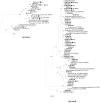Bacterial communities in the sediments of Dianchi Lake, a partitioned eutrophic waterbody in China
- PMID: 22666393
- PMCID: PMC3364273
- DOI: 10.1371/journal.pone.0037796
Bacterial communities in the sediments of Dianchi Lake, a partitioned eutrophic waterbody in China
Abstract
Bacteria play an important role in the decomposition and cycling of a variety of compounds in freshwater aquatic environments, particularly nutrient-rich eutrophic lakes. A unique Chinese eutrophic lake--Dianchi--was selected for study because it has two separate and distinct basins, Caohai with higher organic carbon levels and Waihai with lower organic carbon levels. Sediment bacterial communities were studied in the two basins using samples collected in each season from June 2010 to March 2011. Barcoded pyrosequencing based on the 16 S rRNA gene found that certain common phyla, Proteobacteria, Bacteroidetes, Firmicutes and Chloroflexi, were dominant in the sediments from both basins. However, from the class to genus level, the dominant bacterial groups found in the sediments were distinct between the two basins. Correlation analysis revealed that, among the environmental parameters examined, total organic carbon (TOC) accounted for the greatest proportion of variability in bacterial community. Interestingly, study results suggest that increasing allochthonous organic carbon could enhance bacterial diversity and biomass in the sediment. In addition, analysis of function genes (amoA and nosZ) demonstrated that ammonia-oxidizing bacteria (AOB) were dominant in sediments, with 99% belonging to Nitrosomonas. Denitrifying bacteria were comparatively diverse and were associated with some cultivatable bacteria.
Conflict of interest statement
Figures





References
-
- Ansari AA, Singh Gill S, Lanza GR, Rast W. 2011. Eutrophication: causes, consequences and control: Springer.
-
- Nealson KH. Sediment bacteria: Who's there, what are they doing, and what's new? Annu Rev Earth Pl Sc. 1997;25:403–434. - PubMed
-
- Liu FH, Lin GH, Gao G, Qin BQ, Zhang JS, et al. Bacterial and archaeal assemblages in sediments of a large shallow freshwater lake, Lake Taihu, as revealed by denaturing gradient gel electrophoresis. J Appl Microbiol. 2009;106:1022–1032. - PubMed
-
- Dillon JG, McMath LM, Trout AL. Seasonal changes in bacterial diversity in the Salton Sea. Hydrobiologia. 2009;632:49–64.
Publication types
MeSH terms
Substances
LinkOut - more resources
Full Text Sources

